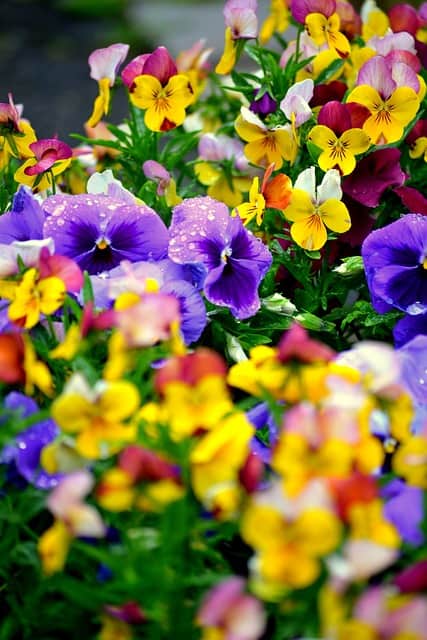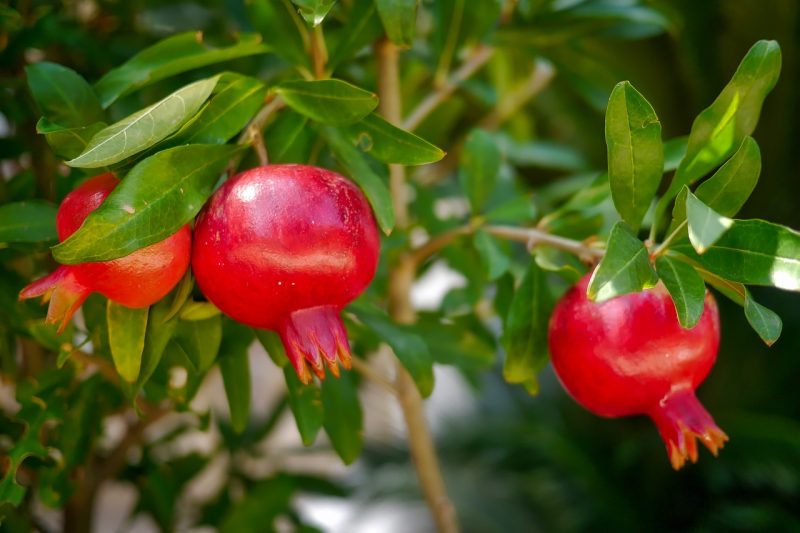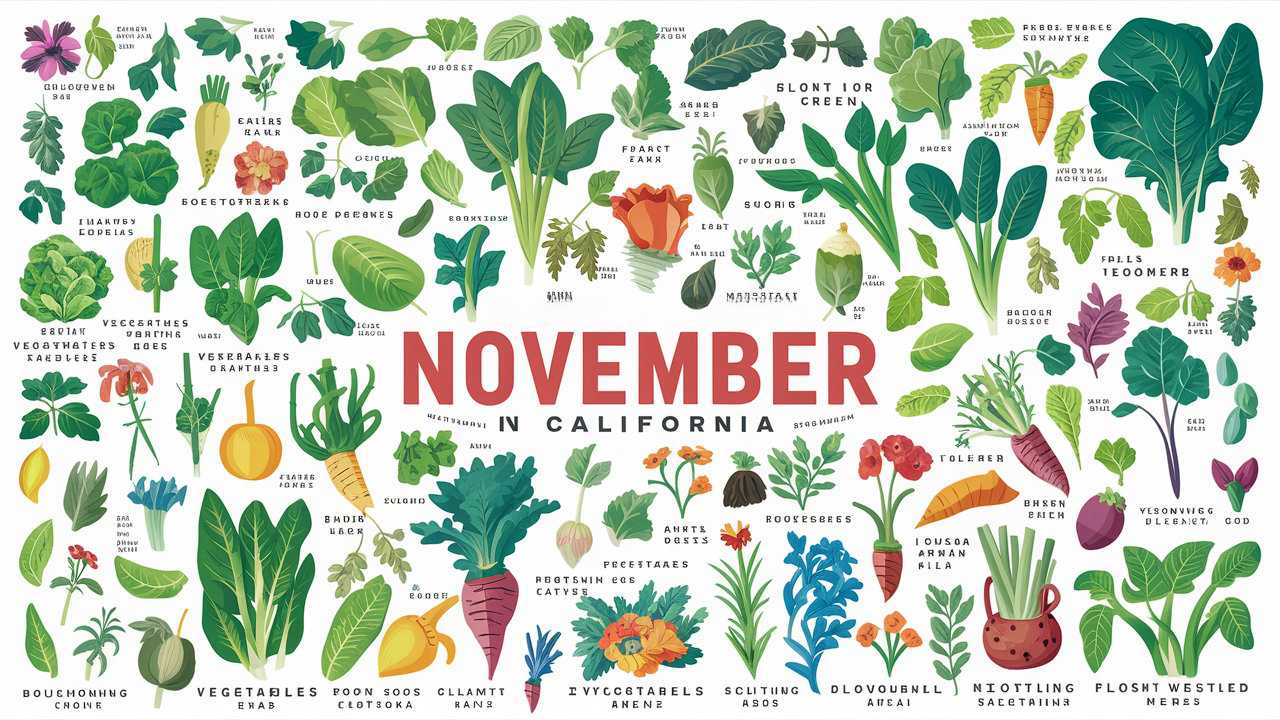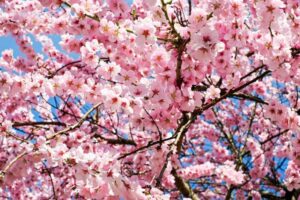As the fall season cools down the Golden State, November brings ideal planting conditions for a variety of delicious and vibrant crops in California. With mild temperatures and ample moisture, this transitional month is perfect for planting cool-season vegetables, flowers, and herbs that thrive in the state’s temperate climate.
California’s Climate Zones
Zone 1: Desert Region
Characterized by scorching summers and mild winters, this area typically sees average yearly temperatures exceeding 77°F.Zone 2: Coastal Zone
Known for its gentle summers and cooler winters, this zone maintains an average annual temperature between 68°F and 77°F.Zone 3: Interior Valleys
This zone experiences hot summers alongside mild winters, with annual temperatures ranging from 61°F to 68°F.Zone 4: Central Valley
Featuring hot summers and cooler winters, the average temperature in this region falls between 50°F and 61°F annually.Zone 5: Northern Coast
Distinguished by cool summers and mild winters, this zone maintains an average yearly temperature of 45°F to 50°F.Zone 6: Northwest Mountains
This area experiences cool summers and cold winters, with average annual temperatures lying between 38°F and 45°F.Zone 7: Sierra Nevada Mountains
Known for its cold summers and harsh winters, the average temperature here ranges from 32°F to 38°F throughout the year.Zone 8: High Desert Region
This zone is characterized by cool summers and extremely cold winters, with average annual temperatures between 27°F and 32°F.Zone 9: Great Basin Desert
Recognized for its very cold winters, this area has an annual average temperature falling below 27°F.
What to Plant in November in California: Zone 1

As the crisp autumn air settles in and temperatures begin to drop, November provides a prime opportunity for gardening in California’s Zone 1. This region, known for its mild climate and extended growing season, allows for a variety of plantings both edible and ornamental. Here’s a closer look at what you can sow and transplant this month to ensure a vibrant, flourishing garden.
Vegetables to Cultivate

November is an excellent time to get a head start on your winter vegetable garden. Here are some top choices for planting this month:
Broccoli: This nutrient-dense cruciferous vegetable thrives in cooler weather. When planted in November, you can expect to harvest your broccoli heads in the spring. Ensure they receive adequate water and sunlight for optimal growth.
Cabbage: Another cool-season crop, cabbage can be direct-seeded or transplanted. It grows well in the fall temperatures and can be harvested before the spring heat becomes intense.
Carrots: Planting carrot seeds directly in the soil now allows them to develop sweet, crunchy roots throughout winter. As they mature slowly, harvesting can extend well into early spring.
Lettuce: Consider various lettuce types, including leaf or romaine varieties, which can be sown this month. They prefer cooler temperatures, making November the perfect time for their quick germination and growth.
Peas: In California’s mild climate, peas can be sown directly into the garden in November. They thrive in the cooler months and will provide a delicious and nutritious harvest in early spring.
Radishes: Fast-growing and easy to cultivate, radishes can be sown directly into the ground. They typically sprout quickly, allowing for multiple harvests before the season shifts.
Spinach: Known for its resilience, spinach thrives in cooler weather and can be planted this month for a bountiful crop. Be sure to provide protection from potential frost with a row cover if needed.
Floral Selections

As you prepare your vegetable garden, don’t overlook the beauty that flowers can bring to your landscape. Here are some excellent choices for November planting:
Pansies: These vibrant flowers not only add color to the garden but also thrive in cooler temperatures. Pansies are hardy and can bloom through the winter into spring, making them a perfect choice for fall planting.
Snapdragons: These iconic flowers are known for their unique shape and versatility. Planting snapdragons in November ensures they establish themselves before winter and bloom gloriously in the spring.
Fruit Trees to Consider

November is also a great time to plant certain fruit trees that will flourish in California’s Zone 1. Here are two excellent candidates:
Citrus Trees: Whether you choose oranges, lemons, or limes, citrus trees can be planted this month. The cooler weather helps them root in well before the warmer spring months arrive. Just make sure they have plenty of sunlight to thrive.
Pomegranate Trees: Pomegranate trees are well-suited to California’s climate and can be planted now for future bountiful harvests. They are drought-tolerant once established, making them a smart choice for sustainable gardening.
What to Plant in November in California: Zone 2
As temperatures cool further in November, California’s Zone 2 presents a fantastic window for establishing a bounty of vegetables, ornamental flowers, and fruit trees. With its slightly cooler climate compared to Zone 1, this zone allows for a rich array of plantings that are well-suited for the developing chill. Here’s a detailed look at the planting options available this month.
Vegetables to Grow
November is a pivotal time in Zone 2 for gardeners looking to maximize their vegetable harvests in the cooler months. Consider these robust vegetative options:
Broccoli: A staple for winter gardens, broccoli can be direct-seeded or transplanted into prepared soil. As it enjoys the cooler air, planting it now will produce delicious florets in early spring.
Cabbage: Hardy and resilient, cabbage thrives in the coolness of November. Planting it this month gives heads ample time to develop, leading to succulent harvests before the onset of warmer temperatures.
Carrots: Ideal for fall sowing, carrots can be sown directly into the ground. They’ll germinate slowly in cooler conditions, leading to crisp, sweet roots that can be harvested as needed through late winter and early spring.
Lettuce: Leafy greens, particularly lettuce, flourish in the milder temperatures of late autumn. This month is perfect for direct sowing various types, ensuring tender and fresh greens are available for salads in the colder months.
Peas: If you’re keen on enjoying a sweet pea harvest in the early spring, plant your seeds now. Peas thrive in cooler weather and will establish well, even in the chill of November.
Radishes: Fast and easy to cultivate, radishes can be sown directly into the garden. They grow quickly, allowing for multiple harvests throughout the winter months, making them a great choice for immediate gratification.
Spinach: With its ability to withstand low temperatures, spinach should be included in your November planting list. It not only matures quickly but also produces an abundant leafy harvest that’s perfect for winter meals.
Floral Choices
Enhance your garden’s beauty with vibrant flower selections that thrive during November in Zone 2. Here are some perfect options:
Pansies: Known for their colorful blooms and ability to withstand cooler weather, pansies are a fantastic addition to your garden this month. They’ll provide cheerful color throughout the winter and into the spring.
Snapdragons: Offering unique shapes and a range of stunning colors, snapdragons can be planted now for winter blooms. They will thrive as the season progresses and bring dynamic interest to your garden with their vertical growth.
Fruiting Trees to Consider
In addition to vegetables and flowers, November is an ideal time to plant fruit trees that appreciate the cooler climate of Zone 2. Here are two fantastic options for your garden:
Citrus Trees: Planting citrus such as oranges, lemons, or grapefruits in November allows them to acclimate to their new environment before the next growing season. They thrive with full sun exposure and will reward you with delicious fruit in the warmer months.
Pomegranate Trees: Pomegranate trees are well-adapted to California’s climates and can be planted in November. Known for their resilience and drought tolerance, these trees will not only enhance your landscape but will also yield sweet and tangy fruits as they mature.
What to Plant in November in California: Zone 3
As November sweeps in and temperatures begin to dip further in California’s Zone 3, it marks a significant shift in gardening opportunities. This zone, characterized by its cooler climate, offers a wealth of options for both vegetable and flower enthusiasts, as well as fruitful trees that can thrive in these conditions. If you’re looking to maximize your garden this month, here’s a detailed guide to the best plants to consider.
Vegetables to Plant
November is a strategic time for sowing and transplanting various vegetables in Zone 3. Take advantage of the cool weather with the following hardy options:
Broccoli: Broccoli is perfect for late fall planting. This nutritious vegetable grows well in cooler temperatures and can be started indoors or direct-seeded outdoors. Ensure you provide enough space for each plant to thrive, as this will enhance air circulation and reduce disease risk.
Cabbage: Known for its versatility and hardiness, cabbage can be transplanted in November. It prefers cooler conditions, providing ample opportunity to establish strong roots before the spring, leading to robust heads ready for harvest.
Carrots: November is the ideal time to direct-seed carrots. These root vegetables appreciate the cooler soil temperatures and will develop sweet flavors as they mature through the winter. Mulching can help protect them from frost.
Lettuce: Fast-growing and delicious, lettuce varieties can be sown this month. Look for varieties such as butterhead or romaine that thrive in cooler weather to ensure a steady supply of fresh greens throughout the winter.
Peas: This legume can be successfully sown in November, taking advantage of the cooler temperatures which help them germinate. Peas will begin to flourish before winter arrives, paving the way for an early spring harvest.
Radishes: For those looking for quick results, radishes are an excellent choice in November. They germinate rapidly and can be harvested within weeks, making them one of the fastest-growing crops you can plant this month.
Spinach: Spinach is incredibly durable and thrives in cooler temperatures. November planting allows this leafy green to grow steadily, providing a constant supply of fresh leaves that can be harvested throughout the winter.
Floral Selections
Brighten up your garden during this cooler season with a selection of flowers that thrive in Zone 3’s November conditions. Consider these perennial favorites:
Pansies: With their vibrant colors and ability to withstand frost, pansies are perfect for late fall planting. They require minimal care and will reward you with blooms that persist through the chilly months.
Snapdragons: Known for their unique shapes and range of colors, snapdragons can be planted in November to establish before winter. They’ll produce stunning stalks that bloom in early spring, creating visual interest in your garden.
Fruit Trees to Consider
November provides a great opportunity to establish fruit trees in Zone 3. Here are two fantastic options that are well-suited for cooler climates:
Citrus Trees: Though many citrus varieties prefer warmer conditions, certain types—such as kumquats, mandarins, and specific lemons—can be planted in November. Ensure they are positioned in a sunny spot for optimal growth and fruiting.
Pomegranate Trees: Adaptable and hardy, pomegranate trees can be successfully established in November. Their drought tolerance makes them a sustainable choice, and they will eventually produce vibrant, sweet fruits as they mature.
What to Plant in November in California: Zone 4
In November, California’s Zone 4 gardeners can revel in the opportunity to plant a diverse range of vegetables, flowering plants, and fruit trees that will thrive in the cooler temperatures. With temperatures dipping further and the season changing, this month is ideal for getting a head start on winter crops and beautifying your garden. Here’s an in-depth look at the best selections to make your garden thrive during this time.
Vegetables to Grow
November is an excellent time for planting a variety of hearty vegetables that can withstand colder weather. Here are some top picks for your Zone 4 garden:
Broccoli: Known for its rich flavor and nutrients, broccoli can be direct-seeded or transplanted in November. This robust vegetable does well in cooler temperatures, allowing for flourishing heads to be ready for harvest by early spring.
Cabbage: Cabbage is a winter favorite, and planting now gives it enough time to establish roots before colder months fully set in. Choose varieties suited for colder climates to ensure a bountiful crop.
Carrots: Directly sowing carrot seeds in November is a great option for this zone. The cool soil will allow the carrots to grow slowly, developing their sweet flavor over time. Be sure to thin them out as they grow to promote larger roots.
Lettuce: As a cool-season crop, lettuce varieties can be seeded now. Opt for both leaf and head types to enjoy a diverse harvest of fresh greens throughout the winter months.
Peas: Planting peas in November takes advantage of the cooler temperatures, which many varieties prefer for germination. You can expect these hardy plants to thrive in the chilly air, providing sweet, tender pods by spring.
Radishes: Radishes are quick to sprout and can be sown directly into the garden. They thrive in cooler weather, making them perfect for late fall sowing, with fast-growing varieties capable of being harvested within weeks.
Spinach: Spinach is exceptionally cold-tolerant and grows well in November. Direct-seed it into your garden for a continual harvest of fresh greens that can withstand frost and provide nutritious meals through the winter.
Floral Selections
Enhancing your garden with vibrance during the cooler months is easily accomplished with flower varieties suited to Zone 4. Consider these beautiful additions:
Pansies: These charming flowers flourish in the cooler months, providing uplifting color and texture to any garden bed. Pansies are hardy and can bloom even in light frosts, making them a reliable choice for winter interest.
Snapdragons: Known for their striking vertical blooms, snapdragons thrive in cooler weather and can be planted in November. These engaging flowers will reward you with vibrant colors and interest as they bloom over the winter into spring.
Fruit Trees to Consider
This month is also a fantastic time to plant trees that will offer fruitful rewards in years to come. Here are two great options for Zone 4:
Citrus Trees: While some citrus varieties flourish primarily in warmer climates, cold-hardy options such as certain mandarins and Meyer lemons can be planted in Zone 4. Select a sunny location to help them acclimate as they grow.
Pomegranate Trees: Pomegranate trees do well in varied climates and can be planted in November. They are drought-resistant, making them sustainable and easy to maintain. Once established, they will reward you with beautiful, flavorful fruit.
What to Plant in November in California: Zone 5
November in California’s Zone 5 presents an excellent opportunity to plant a variety of vegetables, flowers, and fruit trees. With cooler temperatures settling in, it becomes essential to select plants that can withstand the chill and continue to grow beautifully. Here’s a guide for creating a thriving November garden in Zone 5.
Vegetables to Grow
November is a favorable time for planting several hardy vegetables that flourish in cooler weather. Here are the best options for your Zone 5 garden:
Broccoli: This cool-season crop can be directly seeded or transplanted in the cool November air. It develops a delicious head that can be harvested in early spring, making it a staple vegetable for winter gardens.
Cabbage: Cabbage is ideal for fall planting, as it enjoys the cold. Transplanting young plants this month will allow them to establish roots, resulting in sweet, sturdy heads for harvesting through the winter and early spring.
Carrots: Direct sowing carrots in November is a great idea; they thrive in cool soil and can be harvested through winter. With proper spacing, they will grow sweet and crunchy roots that are ready to eat throughout the chilly months.
Lettuce: Various lettuce varieties can be sown now, including leaf, butterhead, and romaine. Lettuce grows quickly in cool temperatures, ensuring a continuous supply of fresh greens for salads and sandwiches.
Peas: November is an excellent time to plant peas, as they prefer cooler conditions for germination. Sowing them now will allow them to grow and give you an early spring harvest of sweet, tender pods.
Radishes: Quick to mature, radishes can be seeded directly into the garden. They thrive in cooler weather and make for an efficient choice, providing fresh, crunchy radishes in as little as three to four weeks.
Spinach: Spinach is exceptionally hardy and can be planted in November. It germinates well in cool soil, providing a continuous harvest of fresh leaves throughout winter, perfect for salads, soups, and other dishes.
Floral Selections
Adding interest and beauty to your garden during the cooler months is vital. Here are some lovely flowers that can thrive in Zone 5:
Pansies: Pansies are a classic choice for winter blooms. Their vibrant colors make them a cheerful addition to your garden, and they can survive light frosts, ensuring colorful displays throughout the winter.
Snapdragons: Known for their tall stature and unique flowers, snapdragons can be planted this month. They will bloom in response to the cooler weather and continue to provide beauty into spring, making them a seasonal favorite.
Fruit Trees to Consider
November is also a suitable time to plant certain fruit trees that can flourish in the cooler climate of Zone 5:
Citrus Trees: While typically more suited to warmer climates, some cold-tolerant citrus varieties, such as certain lemons and mandarins, can be planted. Ensure your trees are placed in a sunny location with good drainage for the best results.
Pomegranate Trees: Pomegranate trees adapt well to cooler climates and can be planted in November. Drought-resistant and low-maintenance, they are an excellent option for gardeners looking for long-term rewards, producing beautiful fruits as they mature.
What to Plant in November in California: Zone 6
As November arrives in California’s Zone 6, gardeners are presented with the perfect opportunity to plant a variety of vegetables, flowering plants, and fruit trees that can thrive in the cooler weather. With the right selections, you can ensure a thriving garden right through the winter months. Here’s a comprehensive guide for your November planting in Zone 6.
Vegetables to Grow
November is a great time to plant cold-hardy vegetables in Zone 6. Here are the top choices for your garden:
Broccoli: This nutrient-rich vegetable does well in cooler temperatures. You can either transplant established seedlings or direct-seed. If planted now, you can expect to harvest fresh broccoli in early spring.
Cabbage: A staple for fall and winter gardens, cabbage can be transplanted or seeded directly. It is very hardy and will produce flavorful heads by spring, thriving in the cooler temperatures.
Carrots: Direct sow carrot seeds in November, as they will germinate well in cooler soil. Carrots can be left in the ground to sweeten with frost and are great for winter harvesting.
Lettuce: Fast-growing and versatile, lettuce can be seeded in November for a continuous supply of fresh greens. You can choose from various types like leaf, romaine, or butterhead.
Peas: Cool-season peas can be planted this month, as they prefer cooler conditions for germination. Sowing them now will set you up for a lovely harvest of sweet peas by spring.
Radishes: Radishes are one of the quickest-growing vegetables, making them perfect for November planting. They can be directly sown, with some varieties ready to harvest in just a few weeks.
Spinach: Spinach is another excellent choice for late fall planting. It is cold hardy and will provide fresh greens throughout the winter months. Direct-seed it into your garden for an ongoing harvest.
Floral Selections
Enhancing your garden with winter-blooming flowers can bring beauty to your landscape. Consider these hardy options:
Pansies: Renowned for their vibrant colors, pansies can thrive in cool weather and will continue to bloom even under light frost. They are a classic choice for winter gardens, adding cheerful colors to your yard.
Snapdragons: With their tall stalks and unique blooms, snapdragons are a wonderful addition to your garden. They can be planted in November and will reward you with colorful blooms that last well into spring.
Fruit Trees to Consider
November is also an ideal time to plant certain fruit trees that can thrive in Zone 6:
Citrus Trees: While citrus typically prefers warmer climates, varieties such as Meyer lemons, certain mandarins, and kumquats can tolerate cooler temperatures. Plant in a sunny area with good drainage.
Pomegranate Trees: These trees are adaptable and can withstand cooler temperatures once established. November planting allows them to develop roots before winter, setting them up for successful growth in the warmer months.
What to Plant in November in California: Zone 7
In November, California’s Zone 7 provides an excellent environment for planting a variety of hardy vegetables, flowering plants, and fruit trees that can thrive in the cooler, yet relatively mild, climate. Here’s a detailed guide on what to plant in your Zone 7 garden this month.
Vegetables to Grow
November is a prime time for sowing and planting cold-tolerant vegetables in Zone 7. Consider the following:
Broccoli: This nutritious vegetable can either be transplanted or directly seeded. Broccoli does well in cooler temperatures, making it a great choice for planting in November. You can expect to harvest fresh heads by early spring.
Cabbage: Cabbage is a staple in winter gardens and is best transplanted in November. It can withstand frost, and with proper care, you’ll enjoy sweet, crunchy cabbage heads by spring.
Carrots: Direct sow carrot seeds in November for a winter harvest. They thrive in cooler weather, and the frost can enhance their sweetness. Be sure to space them properly for optimal growth.
Lettuce: Fast-growing lettuce can be seeded this month for fresh salads throughout the winter. Choose varieties such as leaf, romaine, or butterhead for a mix of textures and flavors.
Peas: Planting peas in November allows them to thrive in cooler weather. They often germinate well in the cool soil, setting you up for a rewarding early spring harvest of sweet peas.
Radishes: With a quick turnaround, radishes can be sown directly into the garden. They grow well in cooler temperatures and can be harvested in as little as 3-4 weeks, making them perfect for late fall planting.
Spinach: Spinach is extremely cold-hardy and can be direct-seeded. Its ability to withstand frost means you can enjoy fresh, nutritious greens throughout the winter.
Floral Selections
To brighten your garden during the cooler months, consider these flowering plants:
Pansies: These cheerful flowers thrive in cooler weather, providing vibrant blooms that can withstand light frost. They’re perfect for adding color and joy to your winter garden.
Snapdragons: Known for their unique shape and vibrant colors, snapdragons can be planted in November, allowing them to bloom through the winter and into the spring, enhancing your garden’s aesthetic appeal.
Fruit Trees to Consider
November is also ideal for planting certain fruit trees that can handle the climate of Zone 7:
Citrus Trees: Though they are generally more suited for warmer climates, some cold-hardy citrus varieties like Meyer lemons and certain kumquats can be planted in Zone 7. Ensure they are protected from colder weather and planted in a sunny spot.
Pomegranate Trees: Pomegranate trees are well-adapted and can be established in this zone. Planting them in November allows them to develop a strong root system that will prepare them for the following growing season.
What to Plant in November in California: Zone 8
November in California’s Zone 8 offers a fantastic opportunity for planting a variety of vegetables that can thrive in the relatively mild climate. Here’s a specialized guide for what to plant this month in Zone 8, focusing on the vegetables that excel during this time.
Vegetables to Grow
In Zone 8, the following vegetables are perfect for planting in November:
Broccoli: This cool-season vegetable can be planted as seedlings or directly seeded. Broccoli thrives in the mild temperatures of November and can be expected to produce heads by early spring. When planting, ensure your plants have good spacing to allow for proper air circulation and growth.
Cabbage: Cabbage is a resilient vegetable well-suited for late fall planting. You can start it from seeds or transplant young seedlings into the garden. Cabbage enjoys cooler weather, which helps develop sweet and crunchy heads. Be sure to keep it watered and monitor for pests.
Carrots: November is an excellent time to sow carrot seeds directly into the ground. Carrots grow well in cooler soil and can remain in the ground until you’re ready to harvest them. The frost can enhance their sweetness, making them a delightful addition to your winter meals.
Gardening Tips for November
Soil Preparation: Ensure your garden beds are well-prepared with compost or well-rotted manure to provide nutrients to your vegetables.
Mulching: Adding a layer of mulch can help retain soil moisture and regulate soil temperature, protecting the roots of your newly planted vegetables from any colder weather.
Watering: While the cooler temperatures may reduce water needs, be attentive to your plants, especially if there’s a dry spell; maintain consistent watering to support healthy growth.
Frost Protection: Although Zone 8 typically has milder winters, it’s wise to keep an eye on the weather forecast. If frost is predicted, be prepared to cover your plants with row covers or other protective materials to shield them from potential damage.






